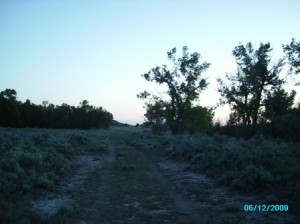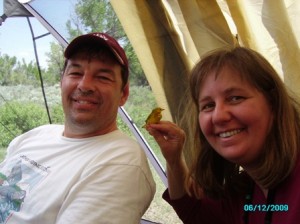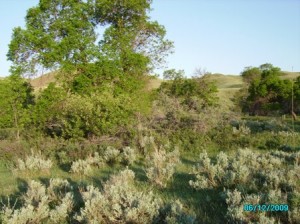Last Friday, John, Nina, and I did our very first banding run at the Canyon Creek MAPS site. Just as a rehash, a MAPS station is a bird-banding station where you catch wild birds in mist nets and look at their physical traits to help assess survivorship and productivity of avian populations. John and Sabrina McNew (Pomona ’09) set up the Canyon Creek site back in 2007.
We got there shortly before sunrise, but the fascinating thing is that this far north, even before the sun is up, the sky is already light. So we opened our nets with chilled fingers (or maybe only my fingers were cold), and kept them open for six hours (as per MAPS protocol). The weather gradually transitioned from cold to hot (50F to 80+ F: Valley County is a cold desert ecosystem), and as it got warmer the bugs (mosquitoes, horse flies, deer flies, no see ums) became more vicious.

This is our study site at dawn (yes, I woke up that early, and yes, it's already light out this far north before the sun rises)
It was a very productive day! In the course of those 6 hours, we caught 16 birds, two of which we recaptured, for a total sample size of 18! We caught brown-headed cowbirds (both female), spotted towhees, yellow warblers (both male, with vivid yellow coloring with saffron streaks), house wrens, field sparrows, and a fledgling Western Meadowlark. An interesting fact is that although summer is breeding season for many of these birds (including the cowbirds), the cowbird females did not have a brood patch. A brood patch is basically a very wrinkly, very veiny patch of skin in the lower belly above the cloaca. Its purpose is to keep an egg warm enough to hatch as the mother sits on it. Brown-headed cowbirds don’t develop brood patches because they are parasites, and one of the females was captured twice from the same net (net 1, which looked pretty darn invisible for a good long time), and that was the site where we also captured the field sparrows. Looks like there might be a cowbird chick poking its head up in a field sparrow nest one of these days!
I was so inspired by the banding run that I decided to continue working on my yard list (list of birds in my “yard”, which I’ve liberally taken to mean the whole trailer park and the grassy neighborhood park behind my trailer). A few young girls saw me wearing my binoculars, looking somewhat crazy, and called me over to help them out. Turns out that they had mistakenly buried a fledgling Common Grackle (looks like a crow) that they thought was dead. I’ve been attempting a very jury-rigged rehab since then, and the little guy is quite tenacious. The girls have decided it’s a female and named it Buttercup, and hopefully Buttercup will pull through! Unfortunately, the grackle has a badly broken right leg (its foot isn’t fully attached).
Moral of this story is to please, please call a qualified wildlife rehabilitation expert if you ever come across an injured animal. They can be dangerous, and more to the point, you can injure them severly if they’re handled improperly (much like how you’re not supposed to move a person who’s broken a bone before calling 911). Most areas have wildlife rehabilitation centers, or emergency vet clinics. And in a pinch, a call to 411 or a quick check online can provide very insightful advice.



